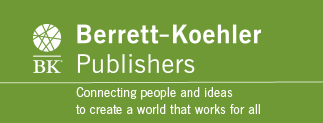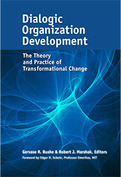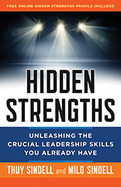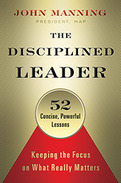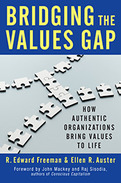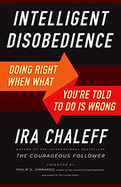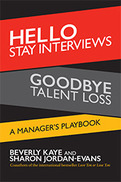Search Results: ""
Results 751-756 of 1358
A Dynamic New Approach to Organizational Change
Dialogic Organization Development is a compelling alternative to the classical action research approach to planned change. Organizations are seen as fluid, socially constructed realities that are continuously created through conversations and images. Leaders and consultants can help foster change by encouraging disruptions to taken-for-granted ways of thinking and acting and the use of generative images to stimulate new organizational conversations and narratives. This book offers the first comprehensive introduction to Dialogic Organization Development with chapters by a global team of leading scholar-practitioners addressing both theoretical foundations and specific practices.
Dialogic Organization Development is a compelling alternative to the classical action research approach to planned change. Organizations are seen as fluid, socially constructed realities that are continuously created through conversations and images. Leaders and consultants can help foster change by encouraging disruptions to taken-for-granted ways of thinking and acting and the use of generative images to stimulate new organizational conversations and narratives. This book offers the first comprehensive introduction to Dialogic Organization Development with chapters by a global team of leading scholar-practitioners addressing both theoretical foundations and specific practices.
Hidden Strengths
2015
Build a Foundation for Continual Growth
In today's turbulent world you need to continually develop new skills to remain agile and adaptive—otherwise, your strengths will become crutches. But contrary to what many people believe, the best way to develop new skills isn't working on your weaknesses—it's identifying and elevating the underdeveloped abilities that lie between your weaknesses and your strengths.
Books like StrengthsFinder 2.0 have helped leaders build on what they're best at—but they stop there. If you only go that far you're missing a huge opportunity for professional growth. Leading Silicon Valley consultants Thuy and Milo Sindell argue that relying exclusively on your top abilities can actually hold you back—it's critical that you expand your repertoire of skills. The most effective way to do that is find your hidden strengths—midlevel skills that can quickly be elevated into learned strengths with attention and focus. This book shows you how.
Too many people waste their time working on their weaknesses, say the Sindells. Although focusing on shoring up weaknesses on the surface makes sense, they've found that it takes too much time and effort—the ROI just isn't there. The neglected skills in the middle, neither strengths nor weaknesses, are where the most potent development opportunities lie. They're close enough to being strengths that putting your energy there can offer a fast and powerful payoff. Us the Sindells' free online Hidden Strengths Assessment, along with the exercises and case studies in the book, you'll be able to identify your most promising hidden strengths and create a plan to turn them into major assets.
In today's work environment, not growing and stretching yourself translates into lack of innovation, stagnation, and obsolescence. You can't keep leaning on the things you're naturally good at or your strengths will become training wheels. But with the Sindells' help, you'll continually develop new skills that will keep you riding at the front of the pack.
In today's turbulent world you need to continually develop new skills to remain agile and adaptive—otherwise, your strengths will become crutches. But contrary to what many people believe, the best way to develop new skills isn't working on your weaknesses—it's identifying and elevating the underdeveloped abilities that lie between your weaknesses and your strengths.
Books like StrengthsFinder 2.0 have helped leaders build on what they're best at—but they stop there. If you only go that far you're missing a huge opportunity for professional growth. Leading Silicon Valley consultants Thuy and Milo Sindell argue that relying exclusively on your top abilities can actually hold you back—it's critical that you expand your repertoire of skills. The most effective way to do that is find your hidden strengths—midlevel skills that can quickly be elevated into learned strengths with attention and focus. This book shows you how.
Too many people waste their time working on their weaknesses, say the Sindells. Although focusing on shoring up weaknesses on the surface makes sense, they've found that it takes too much time and effort—the ROI just isn't there. The neglected skills in the middle, neither strengths nor weaknesses, are where the most potent development opportunities lie. They're close enough to being strengths that putting your energy there can offer a fast and powerful payoff. Us the Sindells' free online Hidden Strengths Assessment, along with the exercises and case studies in the book, you'll be able to identify your most promising hidden strengths and create a plan to turn them into major assets.
In today's work environment, not growing and stretching yourself translates into lack of innovation, stagnation, and obsolescence. You can't keep leaning on the things you're naturally good at or your strengths will become training wheels. But with the Sindells' help, you'll continually develop new skills that will keep you riding at the front of the pack.
What do the best leaders have in common? As president of MAP, John Manning should know. MAP has helped tens of thousands of top executives accelerate their leadership and management performance. Manning says the answer is one word: discipline. But for Manning, discipline has a very specific meaning.
All leaders have scores of things they could do. But a disciplined leader is one who identifies and focuses on the Vital Few: the 20 percent of activities that will drive 80 percent of the results. And the results that are most important are those tied to the organization's most precious asset: its people.
The Disciplined Leader offers fifty-two succinct lessons to help you home in on your own Vital Few in three critical areas: leading yourself, leading your team, and leading your organization. Each lesson comes with recommended tactics and practical “Take Action!” tips for implementing it, so there are literally hundreds of pieces of must-know, time-tested advice here. The chapters are self-contained, so you can read them in any order and come back to the ones that resonate with you—your own Vital Few! This is a hands-on, nuts-and-bolts guide to leadership practice that's built to inspire action, drive change, and achieve results.
All leaders have scores of things they could do. But a disciplined leader is one who identifies and focuses on the Vital Few: the 20 percent of activities that will drive 80 percent of the results. And the results that are most important are those tied to the organization's most precious asset: its people.
The Disciplined Leader offers fifty-two succinct lessons to help you home in on your own Vital Few in three critical areas: leading yourself, leading your team, and leading your organization. Each lesson comes with recommended tactics and practical “Take Action!” tips for implementing it, so there are literally hundreds of pieces of must-know, time-tested advice here. The chapters are self-contained, so you can read them in any order and come back to the ones that resonate with you—your own Vital Few! This is a hands-on, nuts-and-bolts guide to leadership practice that's built to inspire action, drive change, and achieve results.
Bridging the Values Gap
Business has a values problem. It's not just spectacular public scandals like Enron (which, incidentally, had a great corporate values statement). Many companies fail to live up to the standards they set for themselves, alienating the public and leaving employees cynical and disengaged—resulting in lower productivity, less innovation, and sometimes outright corruption.
The reason, argue top scholars and consultants Edward Freeman and Ellen Auster, is that all too often values are handed down from on high, with little employee input, discussion, or connection to the challenges and opportunities facing the organization. Although the words may be well-intentioned, they aren't reflected in the everyday practices, policies, and processes of the organization. This practically invites disconnects between intention and reality.
To bridge this gap between the “talk” and the “walk”, Freeman and Auster provide a process through which organizations can collectively surface deeply held values that truly resonate with everyone, from top to bottom. Their Values Through Conversation (VTC) process focuses on four key types of values conversations: introspective (reflecting on ourselves and how we do things in the organization), historical (exploring our understanding of our past and how it impacts us), connectedness (creating a strong community where we work well together), and aspirational (sharing our hopes and dreams).
By developing values through discussions—casual or formal, one-on-one or in groups—VTC ensures that values are dynamic and evolving, not static words on a wall or a website. Freeman and Auster offer advice, real-world examples, and sample questions to help you create values that are authentic and embraced because they are rooted in the lived experience of the organization.
Business has a values problem. It's not just spectacular public scandals like Enron (which, incidentally, had a great corporate values statement). Many companies fail to live up to the standards they set for themselves, alienating the public and leaving employees cynical and disengaged—resulting in lower productivity, less innovation, and sometimes outright corruption.
The reason, argue top scholars and consultants Edward Freeman and Ellen Auster, is that all too often values are handed down from on high, with little employee input, discussion, or connection to the challenges and opportunities facing the organization. Although the words may be well-intentioned, they aren't reflected in the everyday practices, policies, and processes of the organization. This practically invites disconnects between intention and reality.
To bridge this gap between the “talk” and the “walk”, Freeman and Auster provide a process through which organizations can collectively surface deeply held values that truly resonate with everyone, from top to bottom. Their Values Through Conversation (VTC) process focuses on four key types of values conversations: introspective (reflecting on ourselves and how we do things in the organization), historical (exploring our understanding of our past and how it impacts us), connectedness (creating a strong community where we work well together), and aspirational (sharing our hopes and dreams).
By developing values through discussions—casual or formal, one-on-one or in groups—VTC ensures that values are dynamic and evolving, not static words on a wall or a website. Freeman and Auster offer advice, real-world examples, and sample questions to help you create values that are authentic and embraced because they are rooted in the lived experience of the organization.
When It's Smart to Say No
Nearly every week we read about a tragedy or scandal that could have been prevented if individuals had said no to ill-advised or illegitimate orders. In this timely book, Ira Chaleff explores when and how to disobey inappropriate orders, reduce unacceptable risk, and find better ways to achieve legitimate goals.
The inspiration for the book, and its title, comes from the concept of intelligent disobedience used in guide dog training. Guide dogs must recognize and resist a command that would put their human and themselves at risk and identify safer options for achieving the goal. This is precisely what Chaleff helps humans do. Using both deeply disturbing and uplifting examples, as well as critical but largely forgotten research, he shows how to create a culture where, rather than “just following orders,” people hold themselves accountable to do the right thing, always.
Nearly every week we read about a tragedy or scandal that could have been prevented if individuals had said no to ill-advised or illegitimate orders. In this timely book, Ira Chaleff explores when and how to disobey inappropriate orders, reduce unacceptable risk, and find better ways to achieve legitimate goals.
The inspiration for the book, and its title, comes from the concept of intelligent disobedience used in guide dog training. Guide dogs must recognize and resist a command that would put their human and themselves at risk and identify safer options for achieving the goal. This is precisely what Chaleff helps humans do. Using both deeply disturbing and uplifting examples, as well as critical but largely forgotten research, he shows how to create a culture where, rather than “just following orders,” people hold themselves accountable to do the right thing, always.
Stay interviews prevent exit interviews!
You can't afford to lose them. They're your stars and your solid citizens. You wonder if they're happy in your organization—and what might keep them there. To find out, you could:
A. Conduct a survey—then try to guess who said what.
B. Take note of their latest tattoos. Is your company logo among them?
C. Ask, “What will keep you here?”
The correct answer is C. It's the opening line of a great stay interview, and it could make the difference between keeping and losing your best people.
Worried that your talented people will want things you can't deliver, like more money or a big promotion? Beverly Kaye and Sharon Jordan-Evans have a simple four-step process for dealing with that. Not sure how to get started? They provide dozens of suggested questions and icebreakers. Think you don't have time? They offer all kinds of creative time-saving options for where, when, and how you can do stay interviews.
You can't afford to lose them. They're your stars and your solid citizens. You wonder if they're happy in your organization—and what might keep them there. To find out, you could:
A. Conduct a survey—then try to guess who said what.
B. Take note of their latest tattoos. Is your company logo among them?
C. Ask, “What will keep you here?”
The correct answer is C. It's the opening line of a great stay interview, and it could make the difference between keeping and losing your best people.
Worried that your talented people will want things you can't deliver, like more money or a big promotion? Beverly Kaye and Sharon Jordan-Evans have a simple four-step process for dealing with that. Not sure how to get started? They provide dozens of suggested questions and icebreakers. Think you don't have time? They offer all kinds of creative time-saving options for where, when, and how you can do stay interviews.
